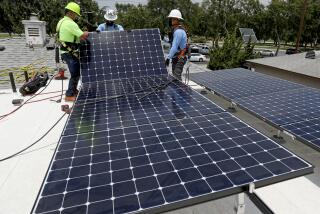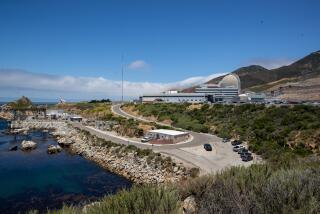San Onofre shutdown will mean tight electricity supplies

SACRAMENTO — Southern California residents will have to get serious about energy conservation, particularly this summer, now that the San Onofre Nuclear Generating Station has been permanently shut down.
Without that nuclear plant, which accounted for about 9% of the electricity generated in California, power supplies will be tight in parts of Los Angeles, Orange and San Diego counties for at least the next three summers, officials said. That means periods of reduced use of air conditioners, lights and swimming pool pumps for customers of Southern California Edison and San Diego Gas & Electric Co.
“Losing 2,250 megawatts from the system is a big deal, and if we ask for conservation, we need them to respond,” said Steve Berberich, chief executive of the California Independent System Operator, which manages most of the state’s long-distance electric transmission system from a control room in Folsom, east of Sacramento.
In the meantime, utilities, state energy officials and grid operators are looking for ways to compensate for San Onofre’s loss.
Those fixes are likely to include pushing for greater energy efficiency in existing buildings and homes; constructing more state-of-the-art natural gas power plants; adding new long-distance transmission lines and speeding up the shift to wind, solar, geothermal and other renewable forms of energy.
Experts and consumer advocates hope the costs of the new infrastructure will be equal to or lower than the hundreds of millions of dollars it would have taken to make San Onofre safe enough to start running again. Californians already pay some of the highest electricity rates in the nation.
The specter of brown-outs or planned blackouts, such as the ones that plagued California at the turn of the millennium, should disappear by 2015 if the state doesn’t have unusually hot weather, a power-plant catastrophe or wildfires that bring down transmission lines, Berberich said.
“I think it will be a distant memory 10 years from now,” he said. “Next summer will not be as challenging as this summer.”
San Onofre’s output, when it ran at full power, produced enough electricity to run more than 1.7 million average Southland homes. Southern California Edison said Friday that it would permanently close the nuclear plant, which had been idle for more than a year after a tube leaked a small amount of radioactive steam.
The expected shortfalls over the next few summers should be felt most strongly in parts of San Diego, Orange and southern Los Angeles County closest to San Onofre.
The city of Los Angeles should have adequate power supplies because its electricity system, run by the Los Angeles Department of Water and Power, is separate from Edison’s.
The rest of California also should have stable power supplies, Berberich said.
Independent power companies, known as merchant generators, say they are ready to boost both their in-state and out-of-state production to fill any immediate needs in the Los Angeles basin and San Diego.
“I think you’re going to see a fairly immediate response by the generator community,” said Jan Smutny-Jones, executive director of the Independent Energy Producers Assn. “You will see a very strong, competitive response to replace those units [at San Onofre]. There still are a lot of resources.”
Those new resources have been building since just after the energy crisis of 2000-01. According to the California Energy Commission, power plants with maximum output totaling about 20,000 megawatts have become operational. An additional 3,900 megawatts are under construction and 4,700 more have been approved and are in pre-construction phases.
The new plants should boost California’s energy independence. The state currently produces about 71% of the electricity it consumes, while it imports 8% from the Pacific Northwest and 21% from the Southwest.
Natural gas was burned to make 45.3% of California’s power generated in-state in 2011. Nuclear power from San Onofre and Diablo Canyon in San Luis Obispo County accounted for 18.3%, large hydropower 18.3%, renewable 16.6% and coal 1.6%.
Many environmentalists hailed Edison’s decision to close San Onofre as the best way to alter the state’s energy production menu in favor of renewables that don’t threaten communities with potential radioactive leaks, such as the one from Japan’s Fukushima Daiichi plant in 2011.
“There’s an opportunity for very creative solutions,” said V. John White, a renewable energy advocate who directs the Center for Energy Efficiency and Renewable Technology in Sacramento. “Everybody is better off by closing it now.”
Kristin Eberhard of the Natural Resources Defense Council praised Edison for cutting its losses.
“Instead of putting Band-Aids on a nuclear plant built decades ago, the company decided to better serve its customers and its shareholders by moving forward with a portfolio dominated by energy efficiency and other clean energy solutions,” said Eberhard, the director for western energy and climate projects.
That new portfolio, even with pricey solar and wind power, should be cheaper than costly nuclear power, said Mindy Spatt, a spokeswoman for a ratepayers’ group, the Utility Reform Network.
Closing San Onofre “should not be used as an excuse to rush out and buy overpriced resources,” she said.







